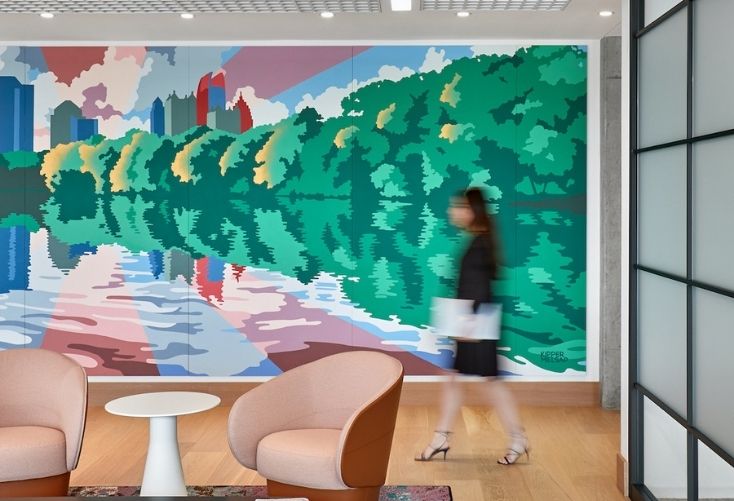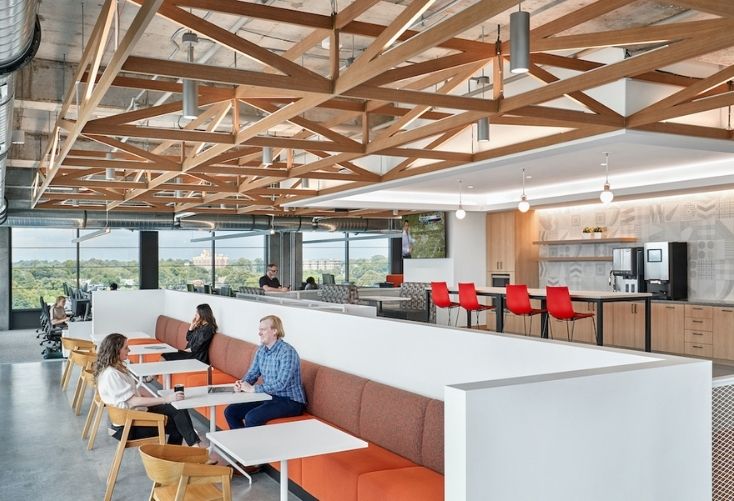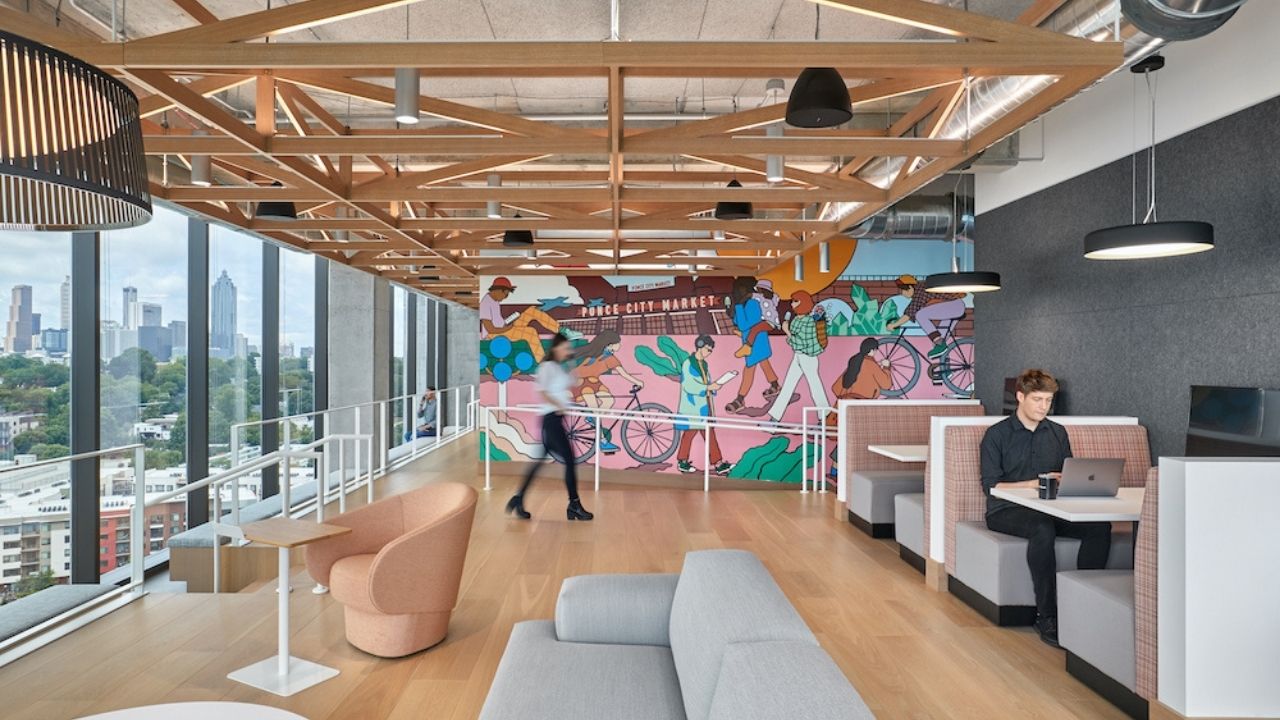- Throughout the pandemic, our collective yearning for the return to a pre-pandemic “normalcy” has only ever seemed to drift further from our grasp.
- Now, work is hybrid and flexible, which brings a mix of hospitality-rich amenities and broadcast studio capabilities to the workplace.
- John Sadlon of Perkins&Will walks us through this period of adaptive exploration.
This article was written by John Sadlon and was originally published on Work Design Magazine.
The onset of Omicron in late 2021 brought with it a resurgence in the ongoing discussions around the future of the workplace. Throughout the pandemic, our collective yearning for the return to a pre-pandemic “normalcy” has only ever seemed to drift further from our grasp. Even before Omicron, consensus seemed to coalesce around the idea of hybrid work as the new normal.
Yet, as we enter the second quarter of 2022, there are encouraging signs of hope. New York has lifted requirements around proof of vaccination, and masking mandates are dissipating. The post-pandemic future is taking shape, which means the industry is embracing a new reality: The New York office market is back, and hybrid is here to stay!

A shift in onus from employee to employer
Many conversations around the future of the workplace are fixated on how to entice employees back to the office. How can businesses achieve the right balance of open and enclosed work areas? How must the workplace adapt for an effective hybrid team dynamic, in support of a more equitable user experience? Many business leaders are overwhelmed by the mosaic of choices and options.
In this crucial moment, we are in a period of adaptive exploration within the workplace. Businesses that strategically invest to realign real estate with employee needs and expectations will accelerate a return to work, and ultimately win the war for talent. Now more than ever, employee needs and expectations will not be met with a one-size-fits-all solution. Different sectors have different priorities that translate into diverging perspectives on what the new workplace should look like.

Seamless integration between remote and in-person
In a world where hybrid work is here to stay, the workplace of the future is increasingly infused with a mix of hospitality-rich amenities and broadcast studio capabilities.
While agility, health and wellness are each universally seen as important factors to a high-performance workplace, how they are implemented across sectors can vary dramatically.
For many businesses, scheduled meetings with clients and collaborators from outside organizations are still digital-first. If the desire is to have employees in the office for such hybrid meetings, the onus is on the employer to provide an enhanced digital experience within the workplace. It’s essential that meeting spaces are designed with lighting and acoustics and sightlines that will keep pace with advanced technology developments, including the integration of high-resolution cameras and ultra-wide screens.
While the Metaverse may not currently be a part of day-to-day work experience of smaller work teams, it will likely revolutionize the way we think about large-scale gatherings of 100 people or more. The range of considerations that architects and designers must take into account are seemingly endless.

The definition of “good design” varies across sectors
Not surprisingly, the marketing and media sectors have been quick to adapt to hybrid models, with pre-existing workflows and processes that lend themselves to remote working. This sector isn’t necessarily looking to downsize real estate footprints, but there has been a shift in how space is being utilized, with a greater emphasis on flexibility and high-impact social spaces. As design professionals, we have had to prioritize agile environments, and a seamless integration of technology.
In contrast, many companies in the financial sector are actively looking to expand real estate footprints to accommodate increased headcount. This sector has performed well over the past year and is propelled to increase physical presence in the office, while still maintaining a focus on health and safety. For example, BlackRock expanded capacity from a 400-strong workforce to 1000 employees in their Atlanta iHub this spring. To keep pace with ongoing recruiting efforts, our firm’s original design of two floors was enlarged to include four floors, encompassing 120,000 square feet in total. The architectural solution leverages BlackRock’s brand and core values to create a strong sense of identity and community among team members, with an array of design elements that tie back to the art, culture and industry of Atlanta.

Respecting the nuances between traditional vs. progressive
Traditionally conservative industries, such as the legal sector, are adapting in more subtle ways. The majority of law practices are focused on incremental steps to achieve greater collaboration and promote engagement across and among all levels of their firms. Progressive firms are focused on providing hospitality-rich spaces for both clients and employees, with greater variety than ever before. In New York City, our design for a confidential client’s new headquarter office provides a variety of food & beverage experiences from a European-inspired café to convenience hospitality stations to full-service formal dining. Services are easily accessible from the firm’s centralized meeting and dispersed collaboration zones, creating a dynamic workplace that breaks the mold of traditional law firm design.
Defining the post-pandemic workplace is greatly influenced by business sector and evolving employee needs. Each has had their own unique experience in the past year and underwent different levels of structural change; some which will stick and some of which will not. The challenge is to strike the right balance of optimized user experience, equitable access to tools and information, as well as clear articulation of culture and brand that is uniquely tailored to each company. Business leaders must ask what is the purpose of their office, and how their workplace must evolve to keep pace with tomorrow’s needs.
A one-size-fits-all approach to the new normal? There’s nothing normal about that.


 Dr. Gleb Tsipursky – The Office Whisperer
Dr. Gleb Tsipursky – The Office Whisperer Nirit Cohen – WorkFutures
Nirit Cohen – WorkFutures Angela Howard – Culture Expert
Angela Howard – Culture Expert Drew Jones – Design & Innovation
Drew Jones – Design & Innovation Jonathan Price – CRE & Flex Expert
Jonathan Price – CRE & Flex Expert












